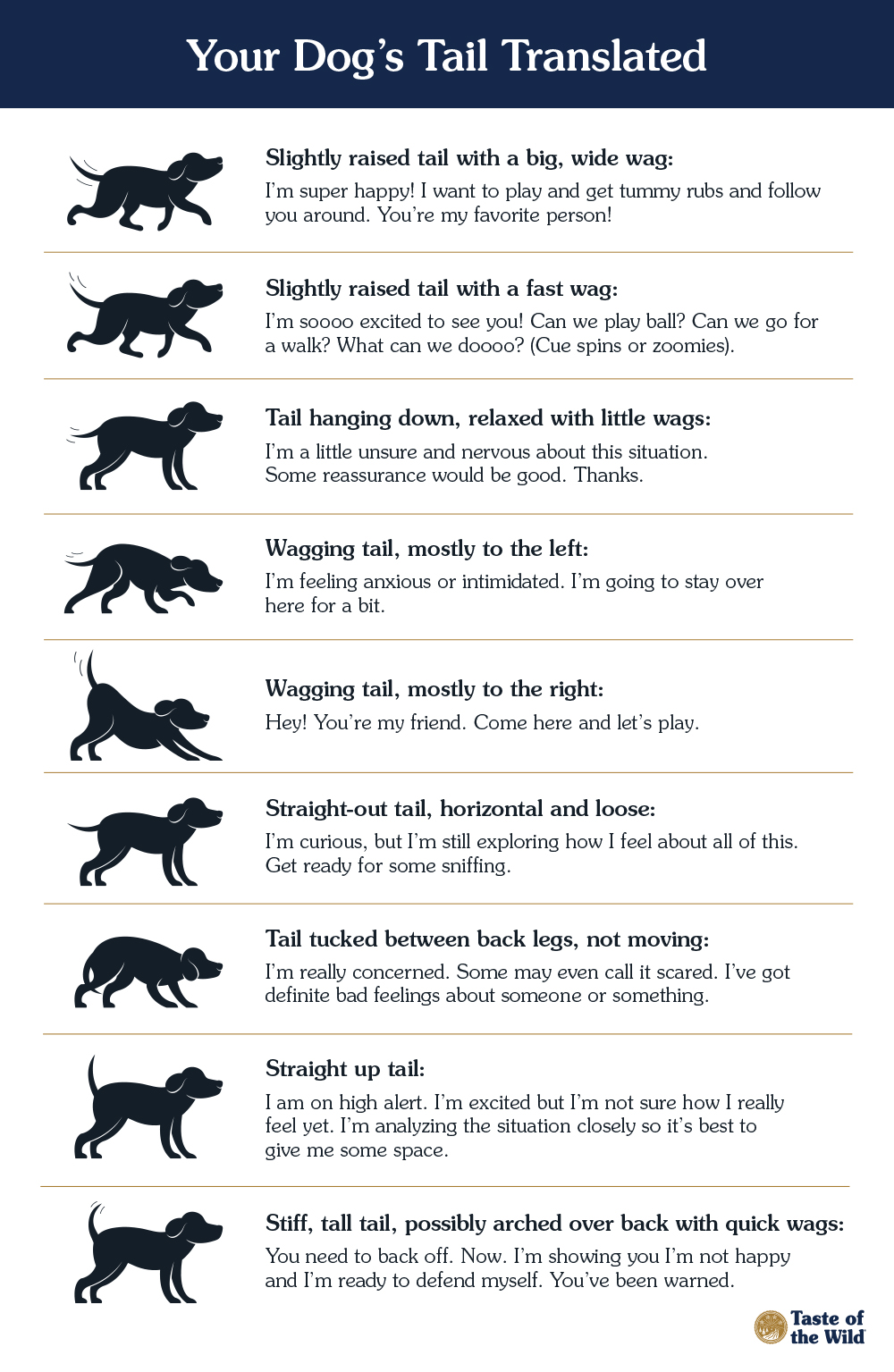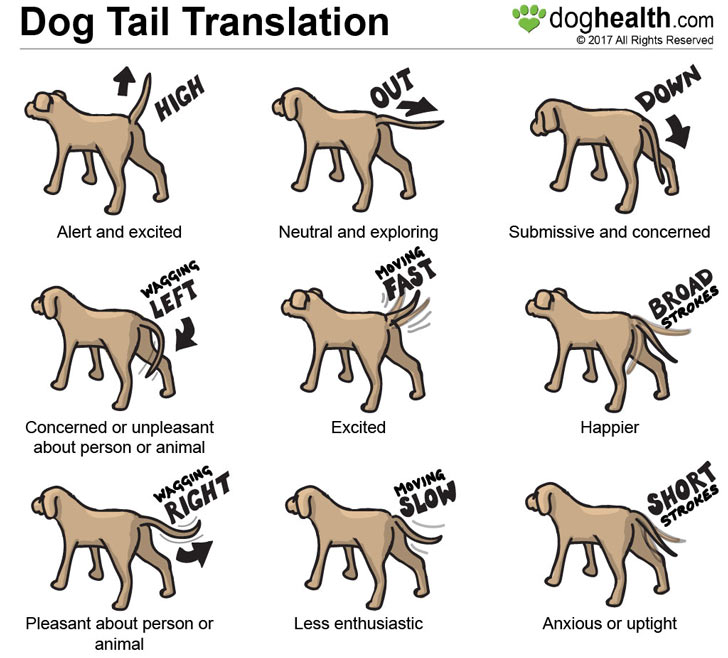When a dogs tail is down, it typically indicates that the dog is feeling fearful, submissive, or unwell. It is a sign of discomfort or unease in the dog’s emotional state. A dogs tail position can convey its mood and should be interpreted within the context of its body language and overall behavior. Understanding the meaning behind a dog’s tail position can help owners and caretakers provide appropriate support and care for their furry companions.
Observing and acknowledging a dog’s body language, including the position of its tail, is essential for effective communication and strengthening the bond between humans and dogs. In the following sections, we will delve into the significance of a dog’s tail position, different tail behaviors, and how to interpret and respond to them.

Credit: www.tasteofthewildpetfood.com
Reasons For A Dog’s Tail Being Down
A dog’s tail position is an important indicator of their emotions and well-being. When a dog’s tail is down, it can signify various reasons ranging from body language cues to underlying physical discomfort. In this blog post, we will explore the different reasons why a dog’s tail may be down, including body language, fear or anxiety, pain or discomfort, and submission or submissiveness.
Body Language
Understanding a dog’s body language is key to interpreting the meaning behind a lowered tail. A dog with an overall relaxed posture and a slight droop in the tail could simply be expressing contentment or relaxation. On the other hand, if a dog’s tail is tucked tightly between their hind legs, it typically indicates fear or anxiety.
Fear Or Anxiety
Fear or anxiety can cause a dog to hold their tail downwards. This lowered tail position is a defensive posture, signaling that the dog is feeling threatened or uncomfortable in their surroundings. It could be triggered by unfamiliar people, loud noises, or other stimuli that they perceive as a potential threat. It’s important to observe the situation and provide a calming environment for the dog to alleviate their anxiety.
Pain Or Discomfort
A dog in pain or discomfort may also hold their tail down as a way to protect the affected area. They may be experiencing physical discomfort due to an injury or an underlying health issue. If your dog’s tail remains consistently lowered, it could be an indication that they need veterinary attention to diagnose and address any potential sources of pain or discomfort.
Submission Or Submissiveness
In a social context, a lowered tail can be a sign of submission or submissiveness. When a dog feels lower in the social hierarchy or wants to appear non-threatening to other dogs or humans, it may lower their tail. It is a way of communicating that they mean no harm and are not challenging the dominance of others. Understanding this body language can help create a harmonious environment for the dog and avoid potential conflicts.
Remember, each dog is unique, and their body language cues may vary. It’s important to consider the overall context and other accompanying behaviors to accurately interpret why a dog’s tail may be down. Maintaining a keen observation and providing a safe and nurturing environment will help ensure the well-being and happiness of your furry friend.
Recognizing A Dog With A Downed Tail
When a dog’s tail is down, it can indicate various emotions and signals that the canine is trying to convey. Recognizing and understanding these cues is essential for proper communication and bonding with our furry friends.
Observing Overall Body Posture
A dog’s overall body posture can provide clues about its emotional state. A downed tail is often accompanied by drooping ears and a hunched or tense body, which can signal fear, submission, or discomfort. Conversely, a relaxed and wagging tail, along with an open and relaxed body language, usually indicates a happy and confident dog.
Noticing Tail Position
The position of a dog’s tail can indicate its mental and emotional well-being. A lowered tail, held below the natural position, might suggest anxiety, fear, or submissiveness. On the other hand, a curled or tucked tail may signal discomfort or distress. Paying attention to tail height and movement can provide valuable insights into a dog’s state of mind.
Looking For Other Behavioral Cues
In addition to the tail, it’s crucial to observe other behavioral cues. For example, a tense or shaking body, avoiding eye contact, or cowering could signify a dog feeling anxious or intimidated. Conversely, a relaxed and playful demeanor usually indicates a happy and content pooch, despite the position of their tail.
Potential Risks And Dangers
When a dog’s tail is down, it can indicate various potential risks and dangers that need to be carefully considered. Understanding these risks is crucial for pet owners to ensure the well-being of their furry friends.
Misinterpretation And Misunderstanding
A dog’s tail being down can often be misinterpreted or misunderstood by humans. This misunderstanding can lead to incorrect assumptions about the dog’s behavior and emotions. It’s essential for dog owners and individuals interacting with dogs to be cautious about making hasty judgments based solely on the position of the tail.
Possibility Of Aggression Or Conflict
The position of a dog’s tail can also indicate the possibility of aggression or conflict. When a dog holds its tail down, it may signal feelings of fear, anxiety, or discomfort, which could potentially lead to aggressive behavior in certain situations. Pet owners need to be aware of these potential signs and take appropriate measures to prevent conflict or aggression.
Indication Of Health Issues
A dog’s tail being down can also be indicative of underlying health issues. If a dog frequently holds its tail in a lowered position, it could be experiencing pain, discomfort, or health problems. This could signify the need for immediate veterinary attention to address any potential health issues and ensure the well-being of the animal.
Helping A Dog With A Downed Tail
When a dog’s tail is down, it could indicate fear, anxiety, or even injury. Understanding the reasons behind a dog’s downed tail can help owners provide the appropriate care and support for their furry friends.
Creating A Safe And Calming Environment
When a dog’s tail is down, it can be a sign that the dog is feeling scared, anxious, or stressed. As a responsible pet owner, it’s important to create a safe and calming environment for your furry companion. Here are some ways to help:
- Ensure your home is a peaceful and secure space. Avoid loud noises, chaotic environments, or situations that may trigger fear or anxiety in your dog.
- Create a designated quiet area where your dog can retreat to when they feel overwhelmed. This could be a specific room or a cozy corner with their favorite toys and bedding.
- Provide plenty of opportunities for mental and physical stimulation through playtime and exercise. Regular exercise can help reduce stress and anxiety levels.
- Consider using pheromone diffusers or calming sprays designed specifically for dogs. These products can help create a soothing atmosphere and promote relaxation.
- Keep a consistent daily routine, including regular feeding times and exercise schedules. Dogs thrive on predictability and routine, which can help them feel more secure.
Providing Positive Reinforcement And Rewards
Positive reinforcement is a powerful tool when it comes to helping a dog with a downed tail. By rewarding desired behaviors, you can help boost your dog’s confidence and gradually improve their overall mood and demeanor. Here are some tips:
- Use treats, praise, and affection to reward your dog for calm and relaxed behavior. This can include moments when their tail is slightly raised or when they display positive body language.
- Focus on rewarding your dog for any sign of improvement, no matter how small. This encourages them to continue making progress and helps build a positive association with certain situations or stimuli.
- Be patient and consistent with your rewards. Dogs learn best through repetition and positive reinforcement. Avoid punishment or scolding, as this can further contribute to their stress and anxiety.
- Consider enrolling your dog in positive reinforcement-based training classes. These classes provide a structured learning environment and can help strengthen your bond with your furry friend.
Consulting With A Professional
If your dog’s tail remains consistently down or if you notice signs of severe stress or anxiety, it’s essential to consult with a professional, such as a veterinarian or a certified dog behaviorist. These experts have the knowledge and experience to assess your dog’s specific needs and provide tailored advice. They may suggest additional techniques or therapies, such as desensitization or counter-conditioning, to help your dog overcome their fears and regain a confident posture.

Credit: www.kidzsearch.com
Ensuring Proper Tail Communication
Understanding and interpreting a dog’s tail position can provide valuable insight into their emotions and intentions. A dog’s tail acts as a key form of communication, and different tail positions can convey various meanings. Ensuring proper tail communication involves recognizing individual tail carriage, understanding the tail up and down the spectrum, and encouraging tail wagging and happiness. By comprehending your dog’s tail language, you can better communicate and strengthen your relationship with your furry friend.
Understanding The Tail Up And Down Spectrum
When it comes to a dog’s tail, not all positions are created equal. By observing a dog’s tail position, you can gain insights into their emotional state. The tail-up and down spectrum ranges from low to high, each representing a different state of mind.
- A tail held low or between the hind legs may indicate fear, anxiety, or submission.
- A tail held horizontally and relaxed generally signifies a calm and content dog.
- On the other hand, a tail held up high, stiff, and vibrating with short rapid movements can indicate excitement or aggression.
By familiarizing yourself with these tail positions, you can better interpret your dog’s emotions and respond accordingly, creating a safe and comfortable environment for your furry companion.
Recognizing Individual Tail Carriage
Just as every dog has a unique personality, each dog also has its preferred tail carriage. Recognizing your dog’s tail position will help you understand their baseline emotions.
- Some dogs have naturally high tail positions, even when relaxed, signaling a generally more alert or dominant demeanor.
- Other dogs may have naturally low tail positions, showing a more submissive or laid-back disposition.
By recognizing and understanding your dog’s unique tail carriage, you can decipher their emotions more accurately and tailor your interactions accordingly.
Encouraging Tail Wagging And Happiness
A wagging tail is often associated with happiness, enthusiasm, and positive emotions in dogs. Encouraging tail wagging can contribute to your dog’s overall well-being. Here are a few tips to foster tail-wagging and a joyful state:
- Provide frequent exercise and playtime to keep your dog physically and mentally stimulated.
- Offer rewards and praise for good behavior to create positive associations.
- Establish a routine and provide a stable environment to reduce stress and anxiety.
- Spend quality time bonding with your dog through training, grooming, and affectionate gestures.
Remember that tail wagging doesn’t always indicate pure happiness. Some dogs may wag their tails in moments of caution or uncertainty, so it’s essential to consider other body language cues for a complete understanding of your dog’s emotions.

Credit: www.doghealth.com
FAQ For What Does It Mean When A Dog Tail Is Down
Why Does A Dog’s Tail Go Down When It’s Feeling Sad?
When a dog’s tail is down, it usually indicates sadness or fear. Dogs use their tails to communicate their emotions. If a dog’s tail is tucked between their legs, it means they are feeling scared or anxious. It’s important to show empathy and try to understand the reason behind their emotions.
Can A Dog’s Tail Be Down If It’s In Pain?
Yes, a dog’s tail can also go down if it’s in pain. When dogs are experiencing discomfort or injury, they may hold their tail down as a protective behavior. If you notice your dog’s tail is constantly down and they exhibit signs of pain or distress, it’s best to consult a veterinarian for a proper diagnosis and treatment.
How Can I Help My Dog When Its Tail Is Down?
If your dog’s tail is down, it is important to be patient and understanding. Avoid scolding or punishing them, as this can exacerbate their negative emotions. Instead, provide a calm and safe environment, offer comforting gestures such as gentle petting, and engage in activities that can uplift their mood, like their favorite toys or treats.
If the issue persists, consult a professional dog trainer or behaviorist for further guidance.
Conclusion
Understanding why a dog’s tail is down is crucial for pet owners to ensure their furry friend’s well-being. It can indicate various emotions and physical conditions, such as fear, anxiety, or injury. By observing their body language and seeking veterinary advice if necessary, we can communicate effectively with our dogs and provide the care they need.
Remember, a wagging tail doesn’t always mean happiness and a drooping tail requires our attention and support.



